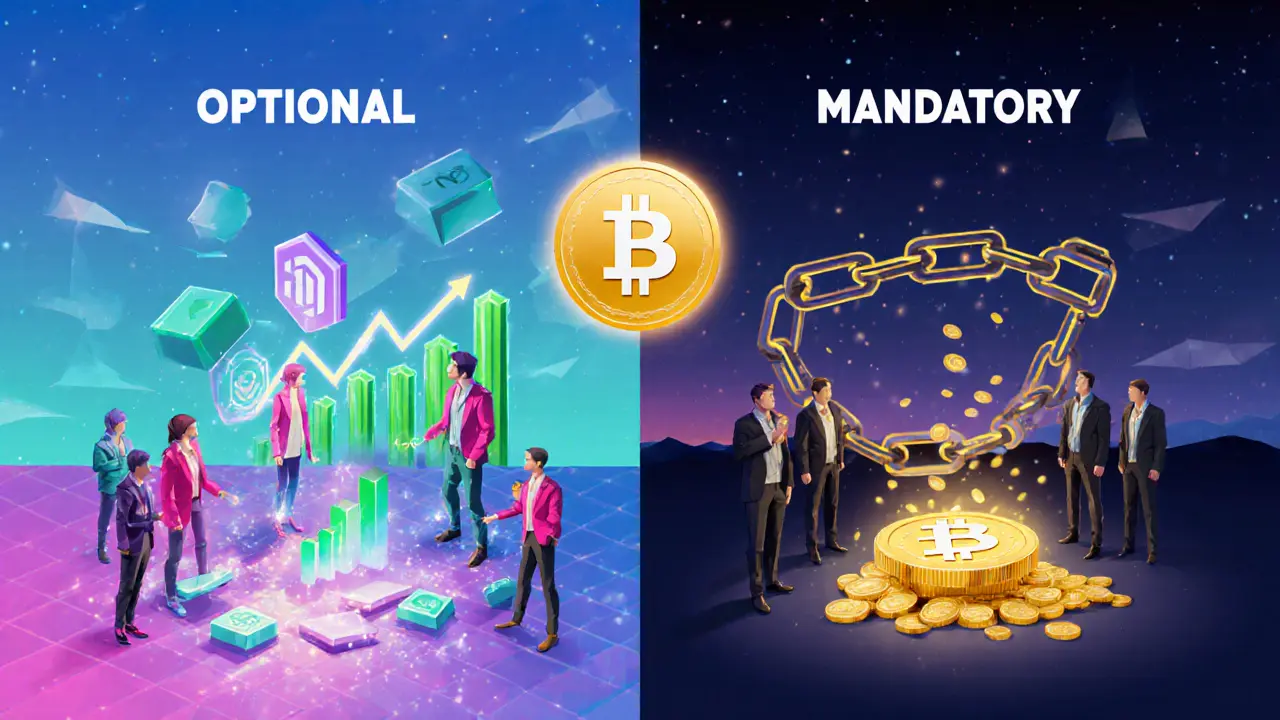Optional vs Mandatory NFT Royalties: Which Model Works Best?

NFT Royalty Model Calculator
Buyers can choose whether to pay royalties. Often leads to higher trading volume but lower creator earnings.
- Marketplace: Blur, Rarible
- Typical royalty: 5-10%
- Creator earnings: ~2% of total sales
- Volume impact: +30% compared to mandatory
Royalties are enforced on-chain. Guarantees creator income but may reduce trading volume.
- Marketplace: OpenSea, Foundation
- Typical royalty: 5-10%
- Creator earnings: ~6% of total sales
- Volume impact: -15% compared to optional
Creator Earnings
$0.00
Based on selected model and parameters
Trading Impact
+30% volume
Optional model typically sees higher trading volume
| Aspect | Optional (e.g., Blur) | Mandatory (e.g., OpenSea) |
|---|---|---|
| Enforcement | Off-chain, buyer can set to 0% | On-chain, fee locked in contract |
| Royalty % | 5-10% (often ignored) | 5-10% (always paid) |
| Daily Volume | ~30% higher | ~15% lower |
| Creator Earnings | ~2% of total secondary-sale value | ~6% of total secondary-sale value |
| Trader Friction | Low - no extra step | Medium - royalty popup & gas cost |
When you buy a digital artwork on an NFT marketplace, a tiny slice of the sale price can go straight back to the creator. That slice is called a NFT royalty a payment to the original creator every time the token changes hands on the secondary market. The big question today is whether that royalty should be optional-letting buyers decide if they want to pay-or mandatory-forcing the fee on every resale. The answer shapes how artists earn, how traders move assets, and even how a marketplace’s tech stack looks.
TL;DR
- NFT royalties are usually 5‑10% of the sale price and are set at minting.
- Optional models (e.g., Blur) let buyers zero‑out royalties, boosting volume but cutting creator income.
- Mandatory models (e.g., OpenSea) enforce fees on‑chain, guaranteeing income but can deter some traders.
- Choosing the right model depends on your priority: consistent earnings vs. maximum liquidity.
- Legal enforceability remains murky-smart contracts are code, not always binding contracts.
How NFT Royalties Are Built
Most royalties live in the smart contract that defines the token. The ERC‑2981 a standard for royalty info that can be read by any marketplace lets creators embed a percentage and a payout address. When the token is transferred, compliant marketplaces read that data and automatically route the fee to the creator’s wallet.
Two token standards dominate the space: ERC‑721 the original single‑token standard and ERC‑1155 a multi‑token standard that can handle both fungible and non‑fungible items. Both can call ERC‑2981 for royalty data, but the key difference isn’t the code-it’s how each marketplace respects (or ignores) that data.
Optional Royalties: The Trader‑Friendly Approach
Blur is the poster child for the optional model. On Blur, a buyer can set the royalty percentage to zero even if the creator programmed a 7% fee. The platform treats royalties as a “tip” rather than a contractual payment, arguing that market forces should dictate whether a collector wants to support the artist.
Pros of the optional model:
- Higher liquidity: Traders can snap up inexpensive copies without extra fees.
- Greater volume: Platforms report up to 30% more daily transactions compared to mandatory‑royalty sites.
Cons of the optional model:
- Lower creator earnings: Average creator take drops from ~6% to ~2% of total secondary‑sale value.
- Unpredictable revenue: Artists can’t rely on a steady trickle of income.
Mandatory Royalties: Protecting Creator Income
OpenSea, the largest NFT marketplace by volume, has built tools that enforce royalties on‑chain. When a collection is flagged as “mandatory,” the marketplace will block listings on platforms that don’t respect the royalty data. In practice, this forces every resale to include the creator‑set fee, usually in the 5‑10% range.
Pros of the mandatory model:
- Guaranteed payouts: Creators receive the programmed percentage on every secondary sale.
- Clear value proposition: Artists can market their work as a sustainable income source.
Cons of the mandatory model:
- Potential volume dip: Traders looking for cheap flips may avoid platforms with non‑negotiable fees.
- Technical overhead: Marketplaces need robust contract audits and on‑chain verification.

Side‑by‑Side Comparison
| Aspect | Optional (e.g., Blur) | Mandatory (e.g., OpenSea) |
|---|---|---|
| Enforcement | Off‑chain, buyer can set royalty to 0% | On‑chain, fee locked in contract |
| Typical royalty % | 5‑10% (often ignored) | 5‑10% (always paid) |
| Average daily volume | ~30% higher than mandatory sites | ~15% lower than optional sites |
| Creator earnings per 100 sales | ~2% of total secondary‑sale value | ~6% of total secondary‑sale value |
| Trader friction | Low - no extra step | Medium - royalty popup & gas cost |
Economic Impact: Volume vs. Revenue
Data from Q22024 shows that platforms using optional royalties processed roughly 1.2million transactions per month, while mandatory‑royalty platforms handled about 870k. However, when you calculate creator payouts, mandatory platforms delivered roughly $4.2million in royalties versus $1.1million from optional platforms. The math shows a classic trade‑off: more trades don’t automatically equal more money for artists.
If a creator cares about a steady cash flow, mandatory enforcement can be the safer bet. If the primary goal is brand exposure and market buzz, an optional model might generate more eyeballs and secondary‑sale chances.
Legal Gray Area
Both Adam Chernichaw a blockchain attorney at White & Case and Prat Vallabhaneni co‑author of several NFT‑law papers note that smart contracts are code, not traditional contracts. They argue that “smart contracts are not really contracts so to speak,” meaning that even if a marketplace enforces a fee technically, a buyer could still dispute it in court, and the legal remedy is uncertain.
Beeple, one of the most successful digital artists, summed it up: “There is zero way to force royalties technologically, so creators will have to build a collector base that want to honor these royalties.” In practice, many creators rely on community goodwill and reputation to keep royalty compliance high, regardless of the enforcement model.
Choosing the Right Model: A Practical Checklist
- Define your revenue priority. If you need predictable cash flow, lean toward mandatory enforcement.
- Know your audience. Collector‑heavy communities (e.g., art‑focused Discords) are more likely to respect optional royalties.
- Assess marketplace reach. OpenSea offers broader exposure but may limit volume if you enforce royalties; Blur offers higher velocity but fewer high‑profile buyers.
- Consider technical overhead. Mandatory models require contract audits and possibly higher gas fees.
- Plan for legal risk. Document royalty terms off‑chain (e.g., in the NFT’s metadata) to strengthen any future legal claim.
Many creators now adopt a hybrid approach-listing collections on both an optional and a mandatory platform, then watching the data. If royalties on the optional side dip below a threshold, they can pull the collection from that marketplace.
Future Outlook
Regulators are starting to look at NFTs as a new asset class. Some jurisdictions may soon require explicit royalty disclosures, which could tilt the field toward mandatory enforcement. On the tech side, upcoming upgrades to Ethereum’s fee model (EIP‑3554) and cross‑chain royalty standards could make on‑chain enforcement cheaper and more universal.
Until a clear legal framework lands, the battle will stay “cat‑and‑mouse”: creators push for guaranteed income, traders push for frictionless markets. Your best move is to stay flexible, monitor your earnings data, and keep an eye on regulatory chatter.

Frequently Asked Questions
What is the difference between optional and mandatory NFT royalties?
Optional royalties let buyers decide whether to pay the fee; mandatory royalties are enforced by the marketplace or smart contract, so the fee is always transferred.
Can a creator force royalty payment on any marketplace?
Technically, only marketplaces that read the ERC‑2981 standard can enforce it. If a platform chooses to ignore the data, the royalty can be bypassed.
Which royalty percentage is most common?
Across major platforms the sweet spot lands around 6% of the sale price.
Do mandatory royalties hurt trading volume?
Data shows a modest dip-about 15% lower daily volume on mandatory‑only sites compared with optional‑only sites.
Is there any legal recourse if a buyer skips royalties?
Legal enforceability is still unsettled. Courts may treat the royalty clause as a contractual term, but evidence and jurisdiction vary widely.

MD Razu
March 19, 2025 AT 05:08The debate over optional versus mandatory NFT royalties is more than a mere pricing strategy; it is a reflection of how we conceive value in the digital age. When we allow buyers to opt‑out of supporting the creator, we are essentially treating art as a commodity devoid of any moral attachment. This optional model feeds the illusion that market liquidity alone can sustain artistic ecosystems, but liquidity without patronage is a hollow promise. Mandatory royalties, on the other hand, encode a social contract into the blockchain, insisting that each exchange acknowledges the original labor. Critics claim that this creates friction, yet friction is the price of respect, and respect is not a free good. The data showing a 30 % volume boost on optional platforms must be read through the lens of long‑term sustainability, not short‑term hype. A creator who earns only 2 % of secondary sales may find their project starved of resources once the initial minting frenzy fades. Conversely, a 6 % guaranteed cut may deter some speculative traders, but it also builds a base of collectors who are invested beyond mere flipping. Think of it as a garden: optional royalties are like watering only when the sun shines, while mandatory royalties are a steady irrigation system. Without the steady flow, plants wither even if occasional rainstorms boost growth temporarily. Moreover, the legal gray area surrounding smart contracts amplifies the risk for creators who rely on optional goodwill. As jurisdictions begin to draft clearer royalty disclosure requirements, the optional model may become legally precarious. Therefore, the “best” model is not a universal truth but a strategic choice aligned with the creator’s risk tolerance and community ethos. Artists who prioritize artistic independence and community building may thrive on optional platforms if they cultivate a culture of voluntary tipping. Those who need predictable cash flow to fund future work should gravitate toward mandatory enforcement, accepting the modest volume sacrifice. In the end, the market will continue to experiment, and the most adaptable creators will be those who can navigate both terrains with agility.
Michael Wilkinson
March 21, 2025 AT 12:41Mandatory royalties are a parasitic tax on traders and a betrayal of free market principles. If you want real liquidity, stop shackling sales with arbitrary fees.
Carl Robertson
March 23, 2025 AT 20:15I see the optional model as a circus where the clowns are the artists begging for crumbs while the real show is the volume stats. The numbers are polished, but they hide the fact that creators are bleeding out. Mandatory royalties? At least they force a painful but honest truth.
Kate Roberge
March 26, 2025 AT 03:48Optional royalties are just a polite excuse for artists to beg for tips.
Jason Brittin
March 28, 2025 AT 11:21Haha, love how Blur makes royalties feel like a side quest 😂. If you’re not paying, you might as well be buying a meme, not art.
VICKIE MALBRUE
March 30, 2025 AT 19:55Stay hopeful creators will find their way. Consistency beats hype.
Naomi Snelling
April 2, 2025 AT 03:28What if the big exchanges are colluding to hide mandatory fees? The system’s designed to keep us guessing.
april harper
April 4, 2025 AT 11:01The optional model sounds sweet until you watch the creator’s wallet shrink. Drama aside, the math is brutal.
Lindsay Miller
April 6, 2025 AT 18:35I get why creators love guaranteed royalties, it gives them peace of mind. At the same time, traders want freedom to move.
Katrinka Scribner
April 9, 2025 AT 02:08Yo the mandatory thign feels like a chain 🤔 but kinda fair? creators need that luv!
Waynne Kilian
April 11, 2025 AT 09:41Both sides have valid points, so maybe a hybrid approach works best. Let the community decide where the line should be.
Billy Krzemien
April 13, 2025 AT 17:15If you’re evaluating which model suits your project, start by mapping your cash‑flow needs versus desired market exposure. Then run a few simulations with the calculator provided.
Clint Barnett
April 16, 2025 AT 00:48When you look at the broader ecosystem, royalties become a lever that can shape creator incentives, collector behavior, and even platform reputation. An optional system encourages a high‑velocity market, which can be attractive for new entrants seeking quick flips, but it also risks creating a pay‑what‑you‑want environment where sustainability is sacrificed on the altar of volume. Mandatory royalties, by contrast, embed a predictable revenue stream into every transaction, fostering long‑term relationships between creators and collectors, yet they may introduce friction that discourages price‑sensitive participants. Ultimately, the decision should be guided by your artistic goals, community expectations, and the trade‑off you’re willing to accept between liquidity and financial security.
Rajini N
April 18, 2025 AT 08:21Just try both platforms for a month and watch the numbers. You'll see which vibe clicks with your audience.
Oreoluwa Towoju
April 20, 2025 AT 15:55Is there any evidence that mandatory royalties actually boost creator earnings long term? I'd love to see a case study.
Amie Wilensky
April 22, 2025 AT 23:28Wow, what a cascade of ideas, each one tumbling over the other, demanding our attention, and yet, amid this torrent, you manage to distill a crystal‑clear thesis, that creators must weigh liquidity against sustainability, and that the market will keep evolving, so adaptability becomes the true virtue!